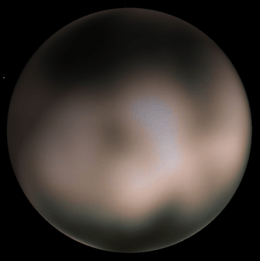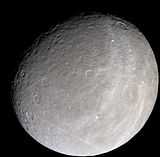Moons of Pluto
| Moons of Pluto | ||||
|---|---|---|---|---|
|
The dwarf planet Pluto has five known moons. In order of distance from Pluto they are Charon, Styx, Nix, Kerberos, and Hydra. Charon, the largest of the five moons, is mutually tidally locked with Pluto, and is massive enough that Pluto–Charon is sometimes considered a double object.
Discovery

The innermost and largest moon, Charon, was discovered by James Christy on June 22, 1978, nearly half a century after Pluto itself. In May 2005, the Hubble Space Telescope Pluto Companion Search Team imaged two more moons, named Nix and Hydra in reference to the New Horizons mission.[1] Two more small moons, Kerberos and Styx, were discovered in 2011 and 2012, respectively.[2] Theoretical simulations suggest that there may be as many as 10 moons and one or more ring systems.[3] However, verification of the existence (or non-existence) of any further Plutonian satellites may need to await the arrival of New Horizons at Pluto on 14 July 2015.
Characteristics
The Plutonian system is highly compact: the five known satellites orbit within the inner 3% of the region where prograde orbits would be stable.

Charon is so massive (being nearly half the diameter of Pluto and an eighth its mass) that the system's barycenter is outside of Pluto's surface.[lower-alpha 1] Charon and Pluto are also tidally locked, so that they always present the same face toward each other. The IAU General Assembly in August 2006 considered a proposal that Pluto and Charon be reclassified as a double planet, but the proposal was abandoned.[4]
Following Buie and Grundy's recent recalculations taking into account older images, the orbits of the moons are confirmed to be circular and coplanar, with inclinations differing less than 0.4° and eccentricities less than 0.005. As seen from Earth, these circular orbits appear foreshortened into ellipses depending on Pluto's position.[5]
When discovered, Hydra was somewhat brighter than Nix, and therefore thought to be larger by 20%. Follow-up observations found them to be nearly identical. It is likely that the change in brightness is due to the light curve of Hydra, but whether this is due to an irregular shape or to a variation in surface brightness is unknown. The diameters of objects can be estimated from their assumed albedos; the estimates above correspond to a 35% albedo like Charon, but the moons could be as large as 130 km if they have the 4% albedo of the darkest KBOs. However, given their color and suspected chemical similarities to Charon, it is likely that their albedos are also similar and that the diameters are closer to the lower estimates.
Formation and resonances

It is suspected that the Plutonian satellite system was created by a massive collision, similar to the "big whack" believed to have created the Moon.[6][7] In both cases, it may be that the high angular momenta of the moons can only be explained by such a scenario. The nearly circular orbits of the smaller moons suggests that they were also formed in this collision, rather than being captured Kuiper belt objects. This and their near orbital resonances with Charon (see below) suggest that they formed even closer to Pluto than they are at present and that they migrated outward as Charon got into its current orbit. If Hydra and Nix turn out to be tidally locked, as Charon is, that will settle the issue, because tidal forces are insufficient to damp their rotations in their present orbits. The color of each is grey, like Charon,[8] which is consistent with a common origin. Their difference in color from Pluto, one of the reddest bodies in the Solar System due to the effects of sunlight on the nitrogen and methane ices of its surface, may be due to a loss of such volatiles during the impact or subsequent coalescence, leaving the surfaces of Pluto's moons dominated by water ice. Such an impact would be expected to create additional debris (more moons), but these must be relatively small to have avoided detection by Hubble. It is possible that there are also undiscovered irregular satellites, which are captured Kuiper belt objects.
Styx, Nix, Kerberos and Hydra form a 1:3:4:5:6 sequence of near resonances with the Charon–Pluto orbital period:[9] Styx is about 5.4% from resonance, Nix is within 2.7% of resonance, Kerberos is apparently within 0.6%, whereas Hydra is within 0.3%, though none appear to be in an exact resonance. It may be that these orbits originated as forced resonances when Charon was tidally boosted into its current geosynchronous orbit, and then released from resonance as Charon's orbital eccentricity was tidally damped. Today the Pluto–Charon pair continue to produce strong tidal forces, with the gravitational field at the outer moons varying by 15% peak to peak. At the lower estimated size range, Nix should have no significant precession, whereas Hydra should have a precession period of 15 years. However, at their maximum projected masses (assuming an albedo of 4%), the two moons may be in a 3:2 orbital resonance with each other, with libration periods of 400 to 450 days, though this may already be ruled out by the low eccentricity of Charon.[10] Thus accurate orbital data can help resolve the sizes of these moons.
However, it was calculated that a resonance with Charon could boost either Nix or Hydra into its current orbit, but not both: boosting Hydra would have required a near-zero Charonian eccentricity of 0.024, whereas boosting Nix would have required a larger eccentricity of at least 0.05. This suggests that Nix and Hydra were instead captured material, formed around Pluto–Charon, and migrated inward until they were trapped in resonance with Charon.[11] The newly found Kerberos and Styx may support this idea.
Table
The Plutonian moons are listed here by orbital period, from shortest to longest. Charon, which is massive enough to have collapsed into a spheroid, is highlighted in light purple. Pluto has been added for comparison, because it orbits a point outside itself.[12]
| Name (pronunciation) |
Image[13] | Mean diameter (km) |
Mass (×1019 kg) | Semi-major axis (km) |
Orbital period (days) |
Orbital period (relative to Charon) |
Eccentricity | Inclination (to Pluto's equator) |
Magnitude (mean) | Discovery date | ||
|---|---|---|---|---|---|---|---|---|---|---|---|---|
| Pluto[14] |  | 2,306 | 1305 ± 7 | 2,035 | 6.387230 | 1 : 1 | 0.0022[lower-alpha 2] | 0.001° | 15.1 | 1930 | ||
| Pluto I | Charon | /ˈʃærən/,[lower-alpha 3] /ˈkɛərən/ |  | 1,207 ± 3 | 158.7 ± 1.5 | 17,536 ± 3* | 6.387230 | 1 : 1 | 0.0022[lower-alpha 2] | 0.001° | 16.8 | 1978 |
| Pluto V | Styx | /ˈstɪks/ | 8–28 | 0.000 ± 0.002 | 42,413 | 20.1617 | 1 : 3.16 | 0.00001 | 0.0° | 27 | 2012 | |
| Pluto II | Nix | /ˈnɪks/ | 46–140 | 0.005 ± 0.004 | 48,690 | 24.8548 | 1 : 3.89 | 0.00000 | 0.0° | 23.7 | 2005 | |
| Pluto IV | Kerberos | /ˈkɜrbərəs/ | 14–44 | 0.002 ± 0.001 | 57,750 | 32.1679 | 1 : 5.04 | 0.00000 | 0.4° | 26 | 2011 | |
| Pluto III | Hydra | /ˈhaɪdrə/ | 59–172 | 0.005 ± 0.004 | 64,721 | 38.2021 | 1 : 5.98 | 0.00554 | 0.3° | 23.3 | 2005 | |
The maximum distance between the centers of Pluto and Charon is 19,571 ± 4 km.
Exploration
The Plutonian system will be visited by the New Horizons spacecraft in July 2015. Besides Pluto and Charon, good images should be returned of Nix. The other small moons will be imaged at lower resolution.[15]
Nix and Hydra can be seen here: http://www.nasa.gov/nh_new-horizons-spots-small-moons-orbiting-pluto/
Notes
- ↑ See "P1P2_motion.avi" (AVI). and barycenter for animations
- ↑ 2.0 2.1 Orbital eccentricity and inclination of Pluto and Charon are equal because they refer to the same two-body problem (the gravitational influence of the smaller satellites is neglected here).
- ↑ Many astronomers use this idiosyncratic pronunciation, rather than the classical /ˈkɛərɒn/, but both are acceptable.
References
- ↑ comcast.net
- ↑ "2 Pluto Moons Get New Names". Retrieved 2013-06-02.
- ↑ "Pluto Could Have Ten Moons". Discovery.com. 18 March 2013. Retrieved 25 March 2013.
- ↑ "The IAU draft definition of "planet" and "plutons"". International Astronomical Union. 2006-08-16. Retrieved 2008-05-17.
- ↑ "Orbits of 4 Bodies in Pluto System about Barycenter as Seen from Earth". Hubblesite. Retrieved 2006-06-21.
- ↑ Canup, R. M. (2005-01-08). "A Giant Impact Origin of Pluto-Charon". Science 307 (5709): 546–550. Bibcode:2005Sci...307..546C. doi:10.1126/science.1106818. PMID 15681378. Retrieved 2011-07-20.
- ↑ Stern, S. A.; Weaver, H. A.; Steff, A. J.; Mutchler, M. J.; Merline, W. J.; Buie, M. W.; Young, E. F.; Young, L. A.; Spencer, J. R. (2006-02-23). "A giant impact origin for Pluto’s small moons and satellite multiplicity in the Kuiper belt" (PDF). Nature 439 (7079): 946–948. Bibcode:2006Natur.439..946S. doi:10.1038/nature04548. PMID 16495992. Retrieved 2011-07-20.
- ↑ "Hubble's Latest Look at Pluto's Moons Supports a Common Birth". Hubblesite. Retrieved 2006-06-21.
- ↑ Matson, J. (11 July 2012). "New Moon for Pluto: Hubble Telescope Spots a 5th Plutonian Satellite". Scientific American web site. Retrieved 12 July 2012.
- ↑ Lee, Man Hoi; S. J. Peale (2006). "On the Orbits and Masses of the Satellites of the Pluto–Charon System". arXiv:astro-ph/0603214 [astro-ph].
- ↑ Lithwick, Y.; Y. Wu (2008). "On the Origin of Pluto's Minor Moons, Nix and Hydra". arXiv:0802.2951 [astro-ph].
- ↑ Satellite data from Buie & Grundy; a, i, e updated with JPL (site updated 2008 Aug 25).
- ↑ Buie: Mapping the surface of Pluto and Charon
- ↑ Pluto data from D. R. Williams (September 7, 2006). "Pluto Fact Sheet". NASA. Retrieved 2007-03-24..
- ↑ "Welcome to the Year of Pluto", Mountain Living, Jan/Feb 2015, p. 49.
- S.A. Stern, H.A. Weaver, A.J. Steffl, M.J. Mutchler, W.J. Merline, M.W. Buie, E.F. Young, L.A. Young, & J.R. Spencer (2006), Characteristics and Origin of the Quadruple System at Pluto, Nature, submitted (preprint)
- Steffl A.J., Mutchler M.J., Weaver H.A., Stern S.A., Durda D.D., Terrell D., Merline W.J., Young L.A., Young E.F., Buie M.W., Spencer J.R. (2005), New Constraints on Additional Satellites of the Pluto System, Astronomical Journal, submitted (preprint)
- Buie M.W., Grundy W.M., Young, E.F., Young L.A., Stern S.A. (2005), Orbits and photometry of Pluto's satellites: Charon, S/2005 P1 and S/2005 P2, submitted (preprint)
- Brozovic, M., Showalter, M. R., Jacobson, R. A., & Buie, M. W. (2015), The orbits and masses of satellites of Pluto, Icarus, 246, 317
- IAU Circular No. 8625, describing the discovery of 2005 P1 and P2
- IAU Circular No. 8686, reporting a more neutral color for 2005 P2
- IAU Circular No. 8723 announcing the names of Nix and Hydra
- Background Information Regarding Our Two Newly Discovered Satellites of Pluto – The website of the discoverers of Nix and Hydra
External links
| Wikimedia Commons has media related to Moons of Pluto. |
- Animation of the Plutonian system
- Hubble Spots Possible New Moons Around Pluto (NASA)
- Two More Moons Discovered Orbiting Pluto (SPACE.com)
| ||||||||||||||
| ||||||||||||||||||||||||||||||||||||||
| |||||||||||||||||||||||||||
| ||||||||||||||
.jpg)



